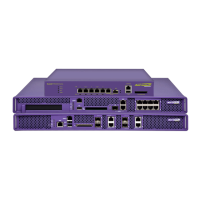AP Management from Controller
Summit WM3000 Series Controller System Reference Guide484
For a review of some important considerations impacting the use of extended and independent WLANs within an AP
deployment, see “AP Deployment Considerations” on page 493.
Configuration Updates
An AP receives its configuration from the controller initially as part of its adoption sequence.
Subsequent configuration changes on the controller are reflected on an AP when applicable.
An AP applies the configuration changes it receives from the controller after 30 seconds from the last
received controller configuration message. When the configuration is applied on the AP, the radios
shutdown and re-initialize (this process takes less than 2 seconds) forcing associated MUs to be
deauthenticated. MUs are quickly able to associate.
Be aware that any configuration changes made directly on the AP will be overwritten once the AP is adopted by the
controller and the configuration file from the controller is received.
Securing Data Tunnels between the Controller and AP
If a secure link (site-to-site VPN) from a remote site to the central location already exists, the AP does
not require IPSec be configured for adoption.
For sites with no secure link to the central location, an AP can be configured to use an IPSec tunnel
(with AES 256 encryption) for adoption. The tunnel configuration is automatic on the AP side and
requires no manual VPN policy be configured. On the controller side, configuration updates are
required to adopt the AP using an IPSec tunnel.
To review a sample AP configuration, see “Sample Controller Configuration File for IPSec and
Independent WLAN” on page 494.
Managing an AP’s Controller Failure
In the event of a controller failure, an AP's independent WLAN continues to operate without
disruption. The AP attempts to connect to other controllers (if available) in background. Extended
WLANs are disabled once controller adoption is lost. When a new controller is discovered and a
connection is secured, an extended WLAN is resumed automatically.
If a new controller is located, the AP synchronizes its configuration with the located controller once
adopted. If Remote Site Survivability (RSS) is disabled, the independent WLAN is also disabled in the
event of a controller failure.
Remote Site Survivability (RSS)
RSS can be used to turn off RF activity on an AP if it loses adoption (connection) to the controller.

